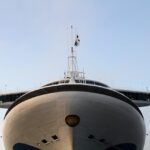The bow is one of the most critical components of a ship, often referred to as the “front” or “fore” part of the vessel. Its design and structure significantly impact the ship’s performance, stability, and handling in various sea conditions. This blog will explore the importance of the ship bow, its design features, and its role in navigation and safety.
Understanding the Bow
The bow is the section of a ship that faces forward when it is underway. It plays a crucial role in the vessel’s ability to cut through water, reducing resistance and enabling efficient travel. The design of the bow is not only about aesthetics; it is a carefully engineered element that influences the ship’s hydrodynamics and overall performance.
Design Features of the Ship Bow
- Shape and Structure
The shape of the bow is designed to minimize water resistance and improve fuel efficiency. There are several common shapes, including:- Bulbous Bow: This design features a protruding bulb at the waterline. It helps reduce wave-making resistance and increases fuel efficiency by improving the flow of water around the hull.
- Clipper Bow: This type has a sharp, pointed design that enhances speed and is often seen in sailing ships.
- Straight Bow: A more traditional design, straight bows are common in cargo ships and tankers. They offer stability and straightforward functionality.
- Material and Construction
The bow must be constructed from durable materials to withstand the harsh marine environment. Steel and aluminum are commonly used due to their strength and resistance to corrosion. Modern shipbuilding techniques also involve using composite materials, which are lightweight and provide additional buoyancy. - Ice Strengthening
In regions where ships operate in icy waters, such as the Arctic or Antarctic, the bow may be specially reinforced to withstand ice impacts. Ice-strengthened bows are typically more robust and have a rounded shape to allow them to break through ice effectively.
Functions of the Bow
- Hydrodynamics and Efficiency
The bow’s shape is designed to enhance hydrodynamics, allowing the vessel to slice through water more efficiently. A well-designed bow reduces drag, enabling the ship to maintain speed while consuming less fuel. This efficiency is vital for long-distance travel and reduces the overall operational costs. - Stability and Handling
The bow plays a significant role in the ship’s stability and handling, especially in rough seas. A well-structured bow helps the vessel maintain its course and resist the forces of wind and waves. This stability is crucial for passenger comfort and safety, as it minimizes excessive pitching and rolling. - Wave Management
The bow is designed to manage waves effectively. A good bow design will deflect incoming waves, preventing water from splashing onto the deck and reducing the risk of flooding. This is particularly important for passenger ships, where comfort and safety are paramount.
The Role of the Bow in Navigation
The bow is essential for a ship’s navigation and maneuverability. Here are some key aspects of how the bow contributes to navigation:
- Heading and Direction
The bow indicates the ship’s direction. When navigating, the captain and crew use the bow as a reference point to steer the vessel accurately. Maintaining a proper heading is crucial for safe travel and avoiding obstacles. - Docking and Berthing
During docking, the bow plays a vital role in maneuvering the ship into position. Crew members must carefully control the ship’s speed and direction to ensure a safe and efficient docking process. Bow thrusters—small propulsion units located at the bow—are often used to aid in this maneuvering. - Visibility and Safety
The bow provides a clear view ahead for the captain and crew, allowing them to spot potential hazards, such as other vessels, buoys, or navigational markers. A well-designed bow enhances visibility, contributing to safer navigation.
Challenges and Considerations
- Bow Damage and Maintenance
The bow is subject to significant stress and potential damage due to collisions with waves, other vessels, or underwater obstacles. Regular inspections and maintenance are essential to ensure its structural integrity and performance. - Environmental Impact
The design of the bow can influence the ship’s environmental impact. For example, a poorly designed bow may create excessive waves, contributing to erosion in coastal areas. As the maritime industry focuses on sustainability, improving bow designs to minimize environmental effects is becoming increasingly important.
Conclusion
The ship bow is a vital component that influences a vessel’s performance, stability, and navigation. Its design is a balance of functionality and engineering, crafted to withstand the rigors of the sea while ensuring efficient travel. Understanding the importance of the bow allows for a greater appreciation of maritime engineering and the intricate details that contribute to successful seafaring. As technology advances, the evolution of bow design will continue to play a crucial role in enhancing the safety and efficiency of modern shipping.

